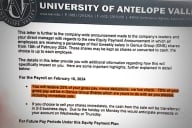You have /5 articles left.
Sign up for a free account or log in.
WASHINGTON -- Any suggestion that Senate Democrats might ease up on their efforts to crack down on for-profit colleges in the new Congress should be laid to rest at this point.
Last week, aides to Senator Tom Harkin (D-Iowa) confirmed that his Committee on Health, Education, Labor and Pensions would hold the next in its high-profile series of hearings on the higher education companies on February 17, though they declined to clarify conflicting reports on whether the hearing would address the use of veterans' education benefits at for-profit colleges or other issues.
And Tuesday, another leading Democrat, Senator Richard Durbin of Illinois, told a group of independent college presidents that he and his colleagues were in a fight to ensure that "we don't end up with another subprime mortgage fiasco" which leaves "low-income students mortgaging their futures not on overpriced homes this time, but on worthless diplomas -- with taxpayers on the hook again for any losses."
In his sharply worded speech at the annual meeting of the National Association of Independent Colleges and Universities, Durbin, the second-ranking Democrat in the Senate, showed no signs of backing away from the aggressive stance he took last summer in a critical letter about the use of military and veterans' education benefits and at a forum he led on for-profit higher education in Chicago.
Durbin acknowledged that there are "many good for-profit schools and they serve a vital purpose," helping Americans move up the economic ladder. But "there are also a lot of bad for-profit schools" that leave students deeply in debt and without meaningful credentials, he said.
Some of his toughest words came when he went off script, recalling the story of a constituent who had testified at his Chicago forum about having accumulated nearly $90,000 in educational debt only to find that police forces and other potential employers declined to recognize the legitimacy of her degree from a for-profit institution.
Durbin said that not long after, he passed a campus of the institution in question, Westwood College, on his way to O'Hare Airport. "I thought, that's the place that fleeced her out of this money," he said. "People must think this is a real college; in my mind it's a travesty."
A Westwood spokeswoman, Kristina Yarrington, said via e-mail that the company had provided information to Durbin showing that the student in question had paid far less in tuition to the college than she claims to have accumulated in debt, that "we showed Durbin how career services worked with this student to help her find work and that many of our criminal justice graduates are working at Chicago-area and Illinois law enforcement agencies."
Durbin, knowing his audience, sought to tap into the anger among officials at many nonprofit institutions about the ever-increasing proportions of federal financial aid that are flowing to commercial colleges.
After noting that students at for-profit colleges are receiving a quarter of all Pell Grant money even though they make up about 10 percent of all students, Durbin told the independent college presidents that their institutions are "under assault" from for-profit institutions that want to "take your students" and are spending "federal tax dollars" to fight the federal government's attempts to regulate them. Durbin said he had fought the tobacco and credit card industries, but "I’ve never seen a lobbying effort like" the one being waged by for-profit colleges.
While the NAICU presidents seemed to appreciate Durbin's critique of their for-profit competitors, they were probably far less keen about his warning that Congress is deeply worried about potential waste of its greatly increased spending on Pell Grants and other higher education investments -- and not just at for-profit institutions.
"There are public colleges and private non-profit colleges that are also failing their students," Durbin said.
"It is time for a serious conversation about the cost and quality of our higher education system," he added. "It’s time to question why we allow some colleges to continue to take in new students when they only graduate 15 or 16 percent of students, year after year. It’s time to question rising tuition and rising student loan debt when students aren’t seeing improvements in outcomes."
And, in a reference to the recent release of Academically Adrift, he said, "it’s time for a serious conversation about a new study that found that nearly half of college students showed no significant improvement in critical thinking, complex reasoning and writing by the end of their sophomore years. And that one-third of students did not take a single course requiring even 40 pages of reading per week."
Mixed Signals on Pell
Durbin was not subtle about attributing his concern about for-profit colleges in large part to the role they've played in driving up federal spending on Pell Grants, which have soared from a program worth about $16 billion in 2008 to one approaching $40 billion in 2011. The large numbers of Americans going or returning to college because of the economic downturn have also contributed to the Pell Grant boom, as have changes that Congress made several years ago that expanded the eligibility criteria for the program. Analysts disagree about which of those factors has had the most impact.
The bottom line, though, is that the Pell program faces a multi-billion-dollar shortfall and is on an unsustainable path -- especially at a time when the newly empowered Republicans in Congress are promising sharp cutbacks in federal spending.
Following Durbin to the podium Tuesday, a Republican Congressional aide warned the college presidents in the room that "things are going to have to be done" to rein in the explosive growth of federal student aid spending. "Don't just come in and say, 'Don't cut Pell, don't cut Pell, don't cut Pell,' " said Amy Jones, who oversees education policy for the House Committee on Education and the Workforce. "There are other things that are going to have to be cut to pay for Pell.... What would you cut?" she asked rhetorically.
Over the next several weeks, Congress will draft a budget for the second half of the 2011 fiscal year that began in October; and on Valentine's Day, President Obama will release his draft budget for the 2012 fiscal year, which lawmakers will debate over the months that follow. College leaders are deeply worried that those deliberations might well lead to cuts in Pell Grants (perhaps by tightening the eligibility criteria that were recently loosened), or that other aid programs dear to them -- Supplemental Educational Opportunity Grants and the Leveraging Educational Assistance Partnership, among others -- will be sacrificed to sustain Pell.
So eager (or desperate) are they for positive signs about Pell that they seized Tuesday on what in normal years would be a perfunctory announcement as evidence of good news. The Education Department is required by law to estimate by February 1 what it believes the maximum Pell Grant will be in the next academic year, so that colleges and families can design their financial aid packages with confidence. Its announcement Tuesday that the maximum award for 2011-12 would be $5,500 drew applause from Democratic lawmakers and from U.S. PIRG, whose higher education advocate, Rich Williams, said that it ensured that "[n]ow millions of parents, students and workers seeking training can count on the funding that is critical to accessing college and a career."
The trick, though, is that the Education Department's announcement does not actually ensure that the Pell Grant will remain at $5,550 next year; Congress could yet decide, as its members deliberate over the 2011 budgets, to cut Pell funding.
But the department's announcement could alter the political dynamic surrounding Pell funding, said Terry W. Hartle of the American Council on Education. "The assumption is that Congress will not want the department to go back in later and say to students and families, 'Congress has cut funding so we need to take away what we said you would get,' " said Hartle, senior vice president for government and public affairs at ACE. "This is no guarantee to ensure the funding, but I think this strengthens the case for a $5,500 Pell Grant."
A Concession on Earmarks
Tuesday also brought word that another flow of federal funds to colleges has gone from threatened to extinguished, at least temporarily. Senator Daniel Inouye, chairman of the Senate Appropriations Committee, announced that his panel would institute a moratorium on direct earmarks for organizations and entities in their districts for the 2011 and 2012 budget cycles.
Earmarks have been a large and growing source of money for colleges' special projects, be they facilities or programs; an Inside Higher Ed analysis last spring found that postsecondary institutions received nearly $2 billion in such grants in the 2010 fiscal year.
But with Republicans vowing to wipe them out, and President Obama promising in his State of the Union speech to veto any legislation that includes them, Inouye conceded that for now, at least, the funds would not flow.









